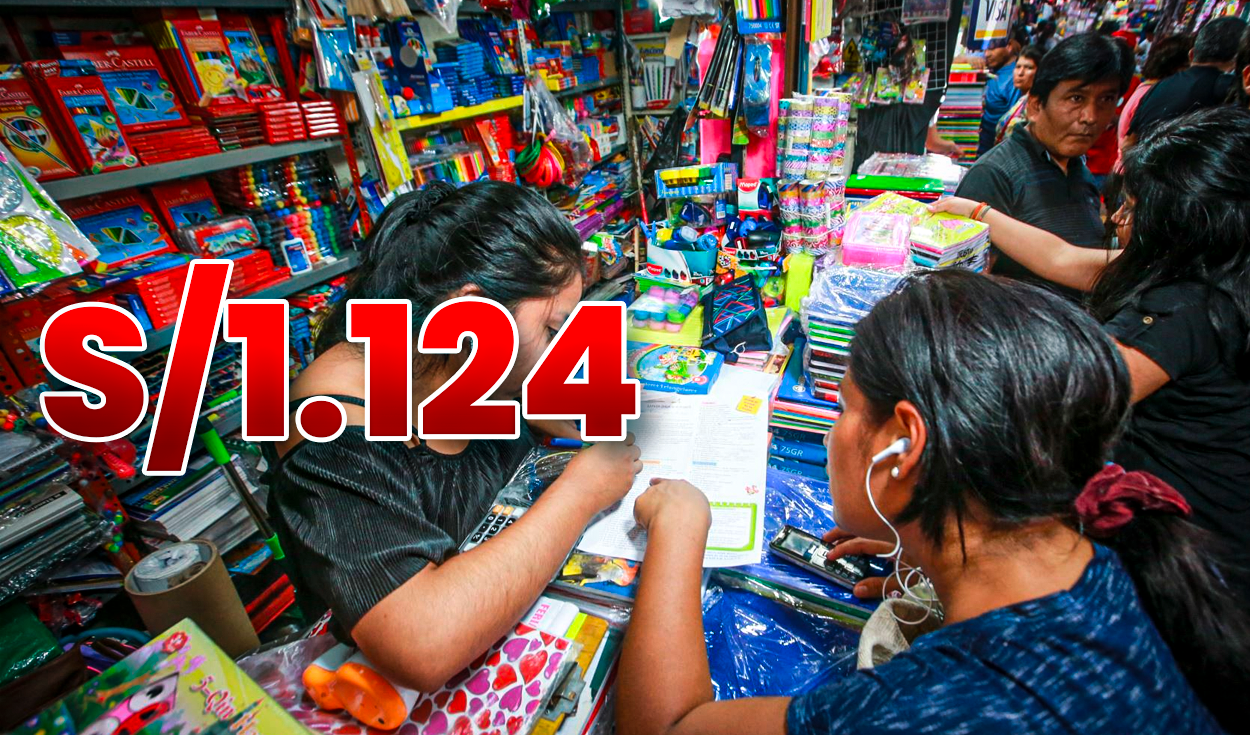
The Active Research Pulse Study on the 2025 school season revealed that Peruvians with school -age (mostly with one or two children) hope to spend for the start of classes a Average S/1,124. For 56.9% of respondents, this amount is higher than the previous year.
In detail, the estimated spending varies according to the socioeconomic level (NSE): S/730 in the NSE D, S/901 in C, S/1,074 in B and S/1,452 in A. A. registration is not considered pension.
Regarding the criteria for the purchase decision, it is summarized in the 3B: Well beautiful and cheap. 41.6% prioritize the price, 28.3% quality, and 21.1% durability. Only 5.6% per brand and 3.4% by recommendation of the educational institution.
Categories
The budget would be for basic school supplies (notebooks, pencils, drafts, etc.) with 87.7%, followed by uniforms (73.2%), shoes (66.9%), backpacks (54.9%) , didactic and complementary material (cards, temperas, etc.) with 52%, lunchboxes (44.4%) and others (2.3%).
In that context, the Republic contacted Susana Saldaña, president of the Gamarra Peru Entrepreneurs Associationto know the prices offered by commercial emporium. As detailed, the costs start from S/5 for a couple of stockings or three underwear garments, S/6 for sports poles, S/8 for shorts, S/10 for blouses, shirts and caps, s/15 for skirts , S/18 for pants, S/25 for backpacks, S/30 for divers and s/35 for jackets, shoes and shoes. He also recommended Searching in Plaza Gallery, Santa Rosa Gallery and the Yuyi Gallery.
“If parents come together, they can buy at wholesale price,” Saldaña recommended.
It should be remembered that at the beginning of the month Pablo Goytizolo, spokesman for the Chamber of Entrepreneurs of Round tablehe estimated for this newspaper that sales will be 40% higher than those of 2024. And he added that since October they have been acquiring “novel products” of Chinese factories that began to be sold in January.
“Next year we may launch a unique platform that brings together all round table entrepreneurs,” Goytizolo said.
However, Susana Saldaña questioned this projection and said that “there is no way” of reaching that growth or, failing that, does not know the calculation mechanisms used to obtain that figure, since “the reality of the country is another.”
Before the Pandemia for the COVID-19, about 5,000 micro and small businesses (Mypes) In Gamarra they dedicated themselves exclusively to the sale of school uniforms. In 2024, as part of their recovery process, they managed to reach 50% of the levels of sale prior to the health crisis.
This year, around 3,500 MYPES participate in the school campaign and hope to recover, at least 60% of their sales level compared to the pre -pandemic stage.
Strategy
Hilario Chong Shing, author of the study, explained to the Republic that the fact that Peruvians prioritize the Prices over quality and durability It demonstrates the effects of inflation and uncertainty.
Therefore, it recommends generating a financing strategy to boost the categories of stagnant products such as backpacks (54.9%), lunchboxes (44.4%) and complementary school supplies, also known as common useful.
According to Ana Reategui, Economics Professor at the ESAN Business School, it translates into the fact that companies give credit to a directly or it access through money credit cards that at the time does not have. “Although it is a good exit, people must be aware of their ability to pay their own financial balance.”
Edmundo Lizarzaburu, professor at the ESAN University Administration and Finance career, explained that it implies accessing:
- Interestless credits and fees: offer payments in fees to relieve the financial charge of school spending and allow the purchase of higher quality products.
- Discounts for early purchase: encourage consumers to acquire products before the high season with exclusive discounts.
- Loyalty programs: benefit recurring customers with cumulative discounts into less demanded categories.
- Promotional packages: combine essential products with the least priority at more accessible prices.
- Alliances with educational institutions: generate agreements with schools to facilitate the acquisition of certain products through payment plans.
For his part, Jorge Carrillo Acosta, an expert in Finance of Pacific Business School, stressed that the priority between quality and price depends on the product. In the case of uniforms, it is advisable to ensure that they last for at least one year.
However, when it comes to backpacks, lunchboards and cartridges, parents must take into account that they are buying for children and adolescents, whose tastes and preferences change over time, so, although the product can last three years, it is likely stop using it before.
Purchase channels
Finally, the study concludes that physical stores continue to be the preferred channel for the purchase of school supplies, with 84.2%, while online stores represent 14.9%.
Chong Shing explained that this preference responds to the need of parents to see and touch the products before buying them, since they will be used by their children.
Sergio Giannotti, Marketing Manager of Mercado Libre, told this newspaper that electronic commerce in the country is still in a growth stage.
“In fact, when comparing ourselves with other countries in the region, we see that our penetration rate ranges between 4% and 5%, while in markets such as Brazil or Chile it reaches between 15% and 20%,” Giannotti explained.
Last year, Mercado Libre registered a 30%growth, with an average ticket of S/400. For this year, the company expects to overcome these figures, driven by economic stability and consumption reactivation.
Source: Larepublica
Alia is a professional author and journalist, working at 247 news agency. She writes on various topics from economy news to general interest pieces, providing readers with relevant and informative content. With years of experience, she brings a unique perspective and in-depth analysis to her work.












